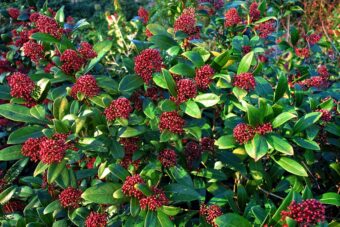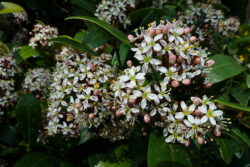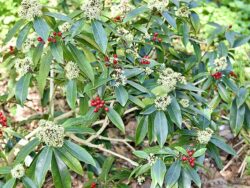In this article, we will be discussing how to grow the wonderfully scented shrub of Skimmia in containers. This time of year in autumn is the best time to buy this compact shrub. It produces evergreen glossy leaves and in spring wonderfully honey-scented male or female flowers open to shout the joys of this season. Once smelled it will not be soon forgotten. In autumn the flowers are followed by beautiful red berries.

This will only happen if a male and female species are within close proximity to each other. It is possible to grow female varieties and have no berries, all because no male is presented. This is okay if you do not mind if the berries are present or not.
Skimmias originate from Japan, China and even from the lower parts of the Himalayas. They are grown for the leaves, the scented flowers and for the beautiful berries that last all winter.
This is one plant that does well in containers and in container displays.
HOW TO GROW SKIMMIAS IN CONTAINERS
First, choose a container that is large enough for the shrub in question, so that it is balanced. Make sure it has plenty drainage holes so that the compost used within it does not become waterlogged. Add a 1cm layer of gravel as this will help any excess water to drain away.
Fill the container with ericaceous compost as the shrub prefers slightly acidic growing conditions. It will not do well in alkaline soils.
Dig a hole slightly bigger than the root ball it came in its original container. Drop the plant in at the same level it came in the original housing-no deeper or shallower. Backfill with the growing media, adding more to any gaps that remain. Firm the plant in and water well with rainwater.

Place the plant where it will get partial shade throughout the year, but it will do well in full shade as well. Not too dark as the plant will grow leggy. This is because, in their natural habitat, it grows in woods and forests. In full sun the leaves will get scorched very easily.
You will need to water frequently until the plant establishes very well. After that, it will tolerate periods of drought, as the leaves are leathery and they retain moisture very well. One thing that must be considered is that all parts are poisonous, especially the berries if eaten. Water well when the compost feels dry.
You will need to fertilize the plant in March and August with a slow-release ericaceous fertilizer. You will need to prune lightly to remove spent flowers in spring. This will not only tidy the plant up but give it a more balanced size and shape.
Skimmias are fully cold hardy and will survive harsh frosts. It is best to move them close to the house, where heat from the home can offer shelter from strong winds and the worse of the frosts.
PESTS AND DISEASES
Skimmias thankfully does not suffer from any major pests or diseases.
One pest that can be a problem is snail and slugs that can take nicks from the leaves. It is best to ignore them as they cause limited damage. If you see any you can handpick slugs and snails or you can use a woolly deterrent mat or slug pellets if you find them a nuisance, but the damage is mostly small.

They can also be attacked occasionally by spider mites but only if it is attacked severely by these pests, then it is best to ignore them. If you want to treat an attack, spray with a suitable insecticide, specially designed for spider mites.
If your Skimmia leaves start to yellow because of chlorosis, caused by the plant’s inability to absorb nutrients because the soil is too alkaline. The solution is to feed with a liquid ericaceous fertilizer at the manufacturer’s recommended dosage and to add a handful of sulphate of iron each spring.
If the leaves are still yellowing it could be a magnesium deficiency. The simple solution is to add a handful of Epsom salts at the recommended dosage and the problem will be soon rectified.
VARIETIES TO GROW
The most common species to grow around the world is Skimmia japonica, which is the hardest of all the varieties. This is my recommendation to grow in containers in the UK.
Skimmia japonica ‘Rubella’ is a male variety that produces deep green, glossy looking leaves and in autumn purple-red flower buds start to appear. In March or April, the flower buds open revealing masses of tiny, white flowers that are heavenly scented.

Another similar variety is Skimmia japonica ‘Fragrans’ whose flower buds are light pink-green and the heavily scented flowers are white-cream.
A female variety to grow is Skimmia japonica ‘Nymans’ that is similar to ‘Rubella’ but not as many flowers are produced. In Autumn, red berries will appear if they are pollinated by a male partner plant.
You may find other varieties but they are not readily seen.
Skimmia x confusa ‘Kew Gardens’ is a Skimmia that looks similar to ‘Rubella’, where the flower buds are lime green and the flowers are more yellowish. Not as colourful as the others.
Skimmia reevesiana is a hermaphrodite that has both male and female flowers. You only need one plant to get berries. In this species, the flowers appear in March or April and are white in colour. These are followed by red berries in late autumn.
CONCLUSIONS
In this article, we have discussed how to grow Skimmias in containers. They are delightful plants that have glossy leaves, wonderfully scented flowers and on female species colourful red berries. They are easy to grow and look after, especially if grown in ericaceous compost and it is watered with rainwater.
You have plenty of choices and makes an ideal container plant.
If you have any questions or comments that you wish to make on growing Skimmia in containers, please do so in the comment box below.
Happy Skimmia growing.

Thank you for a most informative article, I have never grown these, they look really colourful. Mine are going to be in pots. Thank you once again
Hi Patricia
My Pleasure
Thanks
Antonio